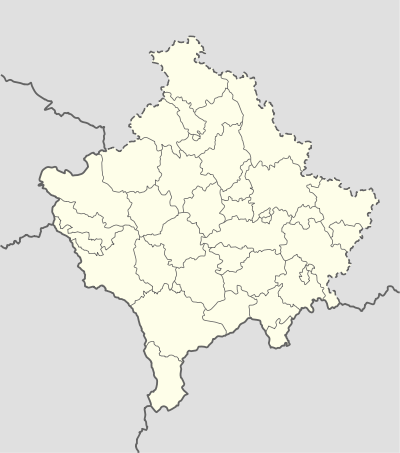Viča, Štrpce
| Viča Вича | |
|---|---|
| Settlement | |
 Viča Location in Kosovo | |
| Coordinates: 42°15′57″N 21°04′50″E / 42.26583°N 21.08056°ECoordinates: 42°15′57″N 21°04′50″E / 42.26583°N 21.08056°E | |
| Country | Kosovo |
| District | District of Ferizaj |
| Municipality | Štrpce |
| Area | |
| • Total | 0 sq mi (0 km2) |
| Elevation | 2,421 ft (738 m) |
| Population (1991) | |
| • Total | 452 |
| Time zone | CET (UTC+1) |
| • Summer (DST) | CEST (UTC+2) |
| Area code(s) | +381 290 |
| Car plates | 05 |
Viča (Serbian Cyrillic: Вича, Albanian: Viqë) is a settlement in the Štrpce municipality in Kosovo. It is inhabited by ethnic Serbs and Albanians,[1] according to the 1991 census, it had 452 inhabitants.
Geography
It is situated in the northeastern part of the Šar Mountains, of which valley sides of the Viča river, a left tributary of the Lepenac.[2] It lies 2 km north of the Prizren-Štrpce-Doganović regional road.[2]
History
In Medieval Serbia, the župa (province) of Sirinić (first mentioned in a charter of the 13th century, the second time in 1331, in a charter of Emperor Stephen Dušan) existed, covering the whole of modern Štrpce municipality, having two cities, Gradište (in Brezovica) and Zidinac (in Gotovuša), near Viča. Several remains of Byzantine forts exist in the region.[3]
The village is part of the ecclessiastical jurisdiction of the Serbian Orthodox Eparchy of Raška and Prizren.
In 1894, the village had 40 houses, of which 35 were Serb, 4 Albanian/Albanized, and one Islamized Serb.[4]
According to data from 1938, the village had the following kin families, with their number of houses, traditions (Krsna Slava, patron saint day), and history:[5][6]
- Karadžić (5 houses, Slava of St. Nicholas), indigenous.
- Velan (12 houses, St. Nicholas), settled from Kabaš, in Metohija, at the end of the 18th century.
- Lukačić (12 houses, St. Nicholas) settled from Dragobilje, in Metohija, at the end of the 18th century. Part of their kin family, which stayed in Metohija, converted into Islam after their departure.
- Alilovit (13 houses), an Albanian family, settled from northern Albania in the 19th century, part of the Berisha fis.
| Ethnic group | 1948 | 1953 | 1961 | 1971 | 1981[7] | 1991 |
|---|---|---|---|---|---|---|
| Serbs | 219 (50,23%) | |||||
| Albanians | 217 (49,77%) | |||||
| Total[8] | 371 | 402 | 408 | 393 | 436 | 452 |
Infrastructure
The rural settlement has primarily livestock farming (ratarsko-stočarstvo).[2]
References
- ↑ Republic of Serbia, Министарствo за Косово и Метохију, Општина Штрпце
- 1 2 3 Srboljub Đ Stamenković, Географска енциклопедиjа населjа Србиjе: С-Ш, Volume 4, Географски факултет, 2002, p. 324
- ↑ Rastko
- ↑ Branislav Đ Nušić, S Kosova na sinje more: beleške s puta kroz Arbanase 1894. godine, Čigoja štampa, 2005, p. 19
- ↑ Podaci „Naselja“ (dr. A. Urošević: Šarplaninska Župa Sirinić)
- ↑ Annuaire, Volume 1, Univerzitet vo Skopje. Prirodno-matematički oddel, Oddel, Jan 1, 1948, p. 174
- ↑ 1981 Census, Kosovo
- ↑ Kosovo censuses 1948-1991
